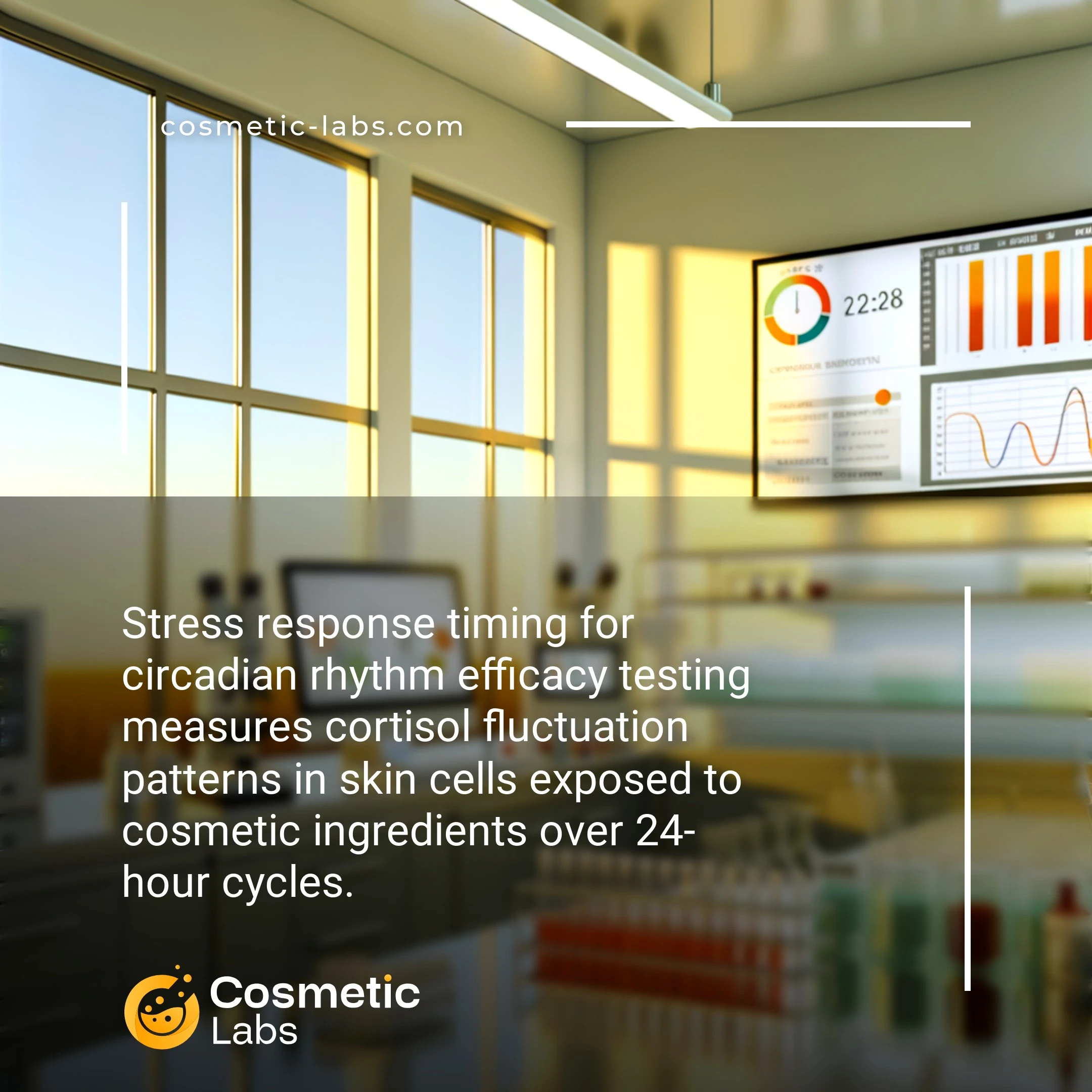Stress Response Timing Tests for Circadian Beauty Products

What is Stress response timing?
Stress response timing for circadian rhythm efficacy testing is a specialized laboratory service that measures how skincare ingredients affect the skin’s natural 24-hour biological clock under stress conditions. Our partner labs use controlled cortisol exposure protocols to simulate real-world stress scenarios, then track how active compounds help maintain healthy circadian gene expression patterns. This testing reveals whether your anti-aging or recovery formulations actually work when customers need them most—during periods of sleep deprivation, environmental stress, or hormonal fluctuations.
Why do you need this service?
Beauty brands leverage stress response timing protocols to validate night repair serums and morning energizing formulations by measuring cortisol fluctuations and cellular recovery patterns at specific time intervals. Labs track how active ingredients perform during peak stress periods versus recovery phases, delivering precise timing data that helps you position products for maximum consumer impact and substantiate circadian-based marketing claims.
Who provides Stress response timing services?
All cosmetic labs providing Stress response timing services
There is no company providing these services at the moment.
Circadian Stress Response Timing Analysis for Beauty Product Efficacy
Circadian stress response timing analysis measures how your cosmetic ingredients affect skin’s natural stress recovery patterns throughout the day. This specialized testing within circadian rhythm efficacy studies reveals when your formulations work best and how they interact with skin’s biological clock.
Cortisol Peak Response Testing
Labs measure cortisol fluctuations in skin tissue samples at specific time intervals to track your product’s impact on stress hormone cycles. Testing typically runs across 24-48 hour periods with samples collected every 2-4 hours. This data shows whether your anti-aging serums or calming treatments actually reduce cortisol spikes during peak stress periods.
Key measurements include:
- Morning cortisol surge response (6-9 AM)
- Afternoon stress peak mitigation (2-4 PM)
- Evening recovery acceleration (8-10 PM)
- Overnight repair enhancement markers
Inflammatory Marker Synchronization
Testing labs track inflammatory cytokine patterns to determine optimal application timing for your products. They measure IL-1β, TNF-α, and IL-6 levels across circadian cycles to identify when skin is most receptive to anti-inflammatory ingredients. This helps brands recommend precise application schedules that maximize product performance.
Results typically show 2-3 hour windows where stress response modulation peaks, allowing you to create targeted usage instructions. Many beauty brands use this data to develop morning versus evening formulations with different active concentrations.
Ready to validate your product’s circadian stress response benefits? Connect with specialized testing labs on our platform to design custom protocols that prove your formulation’s timing-dependent efficacy.
Applications of Circadian Rhythm Stress Response Testing Services
Cosmetic labs use stress response timing for circadian rhythm efficacy testing to validate how skincare ingredients perform across different biological time windows when skin experiences oxidative stress.
Anti-Aging Product Development
Beauty brands developing night repair serums and morning protection formulas rely on circadian stress response data to optimize ingredient timing. Labs measure cortisol fluctuations, melatonin production, and cellular repair markers at 4-hour intervals over 48-hour cycles.
Testing protocols evaluate how retinol derivatives and peptide complexes respond to evening stress peaks versus morning inflammatory markers. This data helps formulators determine whether active ingredients work better during skin’s natural repair phase (10 PM – 2 AM) or during daytime oxidative stress periods.
Targeted Skincare Timing Validation
Product developers use circadian stress response testing to validate claims about “day versus night” formulations. Labs track inflammatory cytokines, antioxidant enzyme activity, and barrier function recovery across circadian cycles while applying controlled stressors.
Testing measures how ingredients like vitamin C stabilizers and ceramide blends perform during peak stress response times (6-8 AM cortisol surge) compared to recovery phases. Results guide marketing claims about optimal application timing and support regulatory documentation for time-specific product benefits.
| Testing Parameter | Morning Peak (6-8 AM) | Evening Recovery (10 PM-2 AM) | Application |
|---|---|---|---|
| Cortisol Response | 85-95% peak levels | 15-25% baseline | Stress protection formulas |
| Antioxidant Activity | 40-50% capacity | 80-90% capacity | Repair serum timing |
| Barrier Recovery Rate | 20-30% efficiency | 70-80% efficiency | Night treatment validation |
| Inflammatory Markers | High IL-6, TNF-α | Low inflammatory response | Soothing ingredient timing |
Connect with specialized cosmetic labs on our platform to access circadian rhythm stress response testing for your next product development project.
